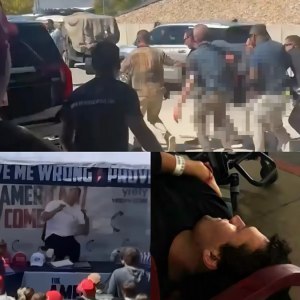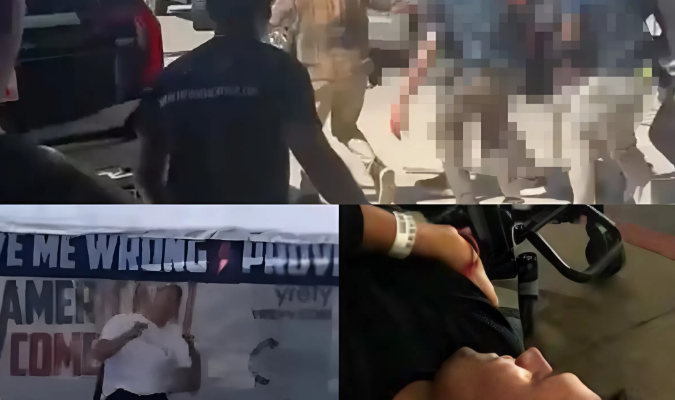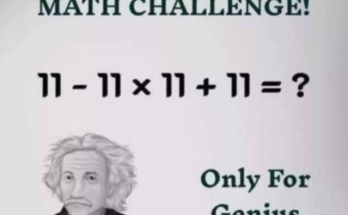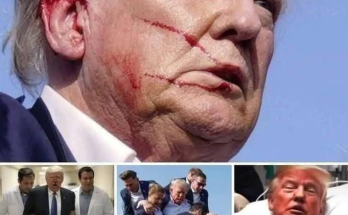
The Final Moments of Charlie Kirk: A Haunting Farewell Captured on Video
On September 10, 2025, conservative activist Charlie Kirk sat beneath a white tent at Utah Valley University, answering questions from students during the first stop of his “American Comeback Tour.” The tent bore the slogan “Prove Me Wrong.” The crowd was large, the mood tense but engaged. Kirk was mid-debate, responding to a question about gun violence, when a single gunshot rang out.
The bullet struck him in the neck. He clutched his throat. He collapsed.
And the cameras kept rolling.
🎥 The Video That Froze a Nation
Multiple angles of Kirk’s final moments have surfaced, each offering a chilling glimpse into the seconds before and after the fatal shot. In , the footage shows Kirk seated, microphone in hand, engaging with a student about mass shootings. His final words—“Counting or not counting gang violence?”—echo just before the shot is fired.
The crowd erupts in panic. Screams pierce the air. Kirk falls sideways, blood visible on his shirt. Security rushes in. Students scatter. The tent collapses in chaos.
In , the live broadcast captures the confusion and horror as attendees realize what has happened. The camera shakes. A voice yells, “Call 911!” Another shouts, “He’s bleeding!”
These videos are not just documentation. They are emotional artifacts—snapshots of a moment that changed the political landscape.
🧑⚕️ The Emergency Response
A doctor on the emergency team later revealed that Kirk was still conscious when paramedics arrived. He was unable to speak but made eye contact. His pulse was weak. The bullet had severed a major artery.
“He was trying to breathe,” the doctor said. “We did everything we could.”
Kirk was rushed to the hospital, but he died en route. The trauma was too severe. The bleeding, unstoppable.
In , reporters confirm the timeline and share reactions from stunned students and faculty. One student says, “It felt like a dream. Like it couldn’t be real.”
🔍 The Shooter and the Investigation
The FBI released surveillance footage of the shooter in , showing the suspect climbing onto a rooftop before firing the shot. He then fled the scene, triggering a nationwide manhunt.
The shooter was later identified as Tyler Robinson, 22, who had posted disturbing messages online in the days leading up to the attack. Authorities found a bolt-action rifle and shell casings engraved with political slogans.
The investigation is ongoing, but the motive appears to be ideological. Robinson had expressed hostility toward Kirk’s views and was reportedly obsessed with political violence.
🧠 The Psychology of a Public Death
Kirk’s assassination was not just a political act—it was a psychological rupture. For many, it echoed the trauma of past political killings. For others, it raised uncomfortable questions about free speech, security, and the cost of ideological warfare.
In , analysts explore the broader implications of Kirk’s death, including the rise of political extremism and the vulnerability of public figures.
The video footage, now viewed millions of times, has sparked debates about content moderation, trauma exposure, and the ethics of sharing violent imagery. dives into these concerns, highlighting the emotional toll on viewers and the need for responsible journalism.
💔 The Family’s Grief
Kirk’s wife, Erika, shared her heartbreak in , vowing to continue her husband’s mission. She appeared beside his empty podcast chair, tears streaming down her face.
“Charlie loved his children. And he loved me. With all his heart,” she said. “And he made sure I knew that every day.”
Erika later posted a video of herself at Kirk’s casket, whispering, “I love you. I love you. I love you.” The footage is raw, intimate, and devastating.
🕊️ The Empty Chair
Kirk’s studio remains untouched. His microphone, silent. His chair, empty.
Turning Point USA announced that the “American Comeback Tour” will continue, with other speakers stepping in. But the absence is palpable.
In , Kirk’s passion and energy are on full display. It’s a stark contrast to the quiet that now surrounds his legacy.
🧩 What the Final Video Reveals
The final video is haunting not just because of the violence, but because of the vulnerability. Kirk was doing what he loved—engaging, debating, challenging. He was mid-sentence, mid-thought, mid-life.
His final words were not scripted. They were part of a conversation. A ritual of public discourse.
And then, silence.
🎤 Final Reflections: The Last Question
The student who asked Kirk the final question later spoke out, expressing sorrow and disbelief. He had disagreed with Kirk’s views but never imagined the conversation would end in tragedy.
“I didn’t want this,” he said. “I just wanted to talk.”
That sentiment—wanting to talk—is what Kirk stood for. He believed in debate. In disagreement. In showing up.
And in the end, he died doing exactly that.


